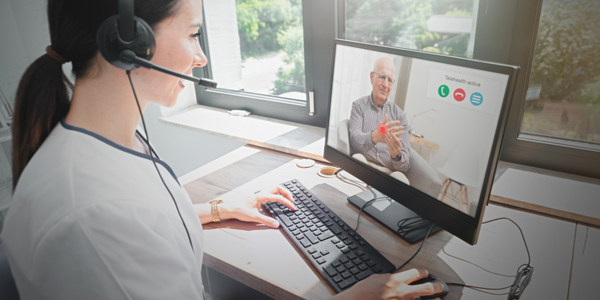Telehealth for Seniors: Taking Advantage of the Modern House Call

The COVID-19 pandemic has changed nearly every aspect of our lives, including how we seek medical treatment. Just a few months ago, we could walk into our doctors’ offices, and the only people wearing masks were those in the lab. But those days are over—at least for now.
Depending on where you live, you may not have seen your doctor face-to-face for routine or non-COVID-related reasons for several months. And, even if you do make an in-person appointment, it’s far different than in January.
You’re probably used to seeing your medical provider whenever you’d like, so these changes might be upsetting. But, believe it or not, you still can! You can safely get the medical consultations you need through telehealth for seniors.
What is telehealth for seniors?
“Telehealth” probably sounds like a complicated tech word. But telehealth just means meeting with your medical provider over the phone or on a video call. When you call to make a doctor’s appointment today, you’ll probably be asked if you want an in-person or telehealth visit.
If you choose telehealth, you’ll receive instructions on how to connect to the appointment at your specified time. You’ll need a smartphone, computer or tablet with a camera to connect with your doctor.
Seeing your physician via telehealth is a great way to avoid getting sick, prevent the spread of COVID-19 and still get the critical care you need. While it may feel strange, this type of visit is just as effective as physically going to the doctor. And telehealth for seniors is the same as a regular visit, your privacy will be protected, and your medical information will remain confidential.
Hate waiting rooms?
The average telemedicine appointment takes 13 to 15 minutes from start to finish unlike in-person visits that average about two hours! Patients also report greater satisfaction after a telehealth visit. Eighty-five percent of people report having their needs met during a telehealth appointment while a recent survey put the satisfaction rate for in-person visits at just 64 percent.
How has COVID-19 changed telehealth?
Telehealth, and specifically telehealth for seniors, isn’t new. It’s been around for several years. But usually only those with extremely fragile health, limited mobility or at high risk for infections used telehealth. Not anymore!
Even before the COVID-19 pandemic telehealth visits for regular patients were on the rise. Between 2005 and 2014, telemedicine visits increased an average of 52 percent annually. And in 2018, 25 percent of Americans reported having a telemedicine visit.
But since March 2020, telehealth visits have become all but the norm. In fact, many states went through periods when all visits except for emergencies were online.
Although the full impact of COVID-19 on telehealth remains unknown, there was an 11,718 percent increase in Medicare beneficiaries participating in a remote medical appointment during the first 45 days of the pandemic.
Does Medicare cover telehealth for seniors?
Billing for telehealth visits is usually the same as a regular visit. Your provider will send you a bill for your contracted copay. Every insurance plan is different, though, and some have changed their telehealth policies in the wake of the pandemic.
Click here for more information from medicare.gov about COVID-19 and its impact on telehealth. If you aren’t sure if your plan includes telehealth coverage, consult with an insurance professional at My Senior Health Plan today.
image credit: shutterstock/Proxima Studio
- How Medicare Advantage Plans Cover Seniors’ Vision, Hearing, and Dental Needs - October 29, 2024
- 2025 Medicare Part D Changes: How to Save on Prescriptions - October 25, 2024
- Everything You Need to Know About the 2025 Medicare Changes and How They Affect You - October 21, 2024

